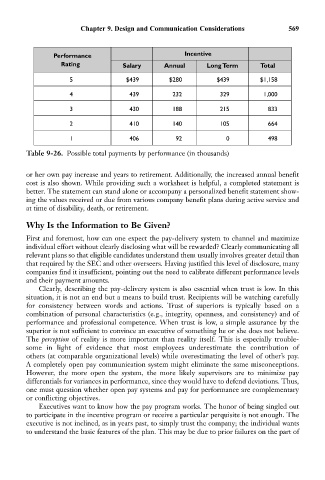Page 583 - Bruce Ellig - The Complete Guide to Executive Compensation (2007)
P. 583
Chapter 9. Design and Communication Considerations 569
Performance Incentive
Rating Salary Annual Long Term Total
5 $439 $280 $439 $1,158
4 439 232 329 1,000
3 430 188 215 833
2 410 140 105 664
1 406 92 0 498
Table 9-26. Possible total payments by performance (in thousands)
or her own pay increase and years to retirement. Additionally, the increased annual benefit
cost is also shown. While providing such a worksheet is helpful, a completed statement is
better. The statement can stand alone or accompany a personalized benefit statement show-
ing the values received or due from various company benefit plans during active service and
at time of disability, death, or retirement.
Why Is the Information to Be Given?
First and foremost, how can one expect the pay-delivery system to channel and maximize
individual effort without clearly disclosing what will be rewarded? Clearly communicating all
relevant plans so that eligible candidates understand them usually involves greater detail than
that required by the SEC and other overseers. Having justified this level of disclosure, many
companies find it insufficient, pointing out the need to calibrate different performance levels
and their payment amounts.
Clearly, describing the pay-delivery system is also essential when trust is low. In this
situation, it is not an end but a means to build trust. Recipients will be watching carefully
for consistency between words and actions. Trust of superiors is typically based on a
combination of personal characteristics (e.g., integrity, openness, and consistency) and of
performance and professional competence. When trust is low, a simple assurance by the
superior is not sufficient to convince an executive of something he or she does not believe.
The perception of reality is more important than reality itself. This is especially trouble-
some in light of evidence that most employees underestimate the contribution of
others (at comparable organizational levels) while overestimating the level of other’s pay.
A completely open pay communication system might eliminate the same misconceptions.
However, the more open the system, the more likely supervisors are to minimize pay
differentials for variances in performance, since they would have to defend deviations. Thus,
one must question whether open pay systems and pay for performance are complementary
or conflicting objectives.
Executives want to know how the pay program works. The honor of being singled out
to participate in the incentive program or receive a particular perquisite is not enough. The
executive is not inclined, as in years past, to simply trust the company; the individual wants
to understand the basic features of the plan. This may be due to prior failures on the part of

